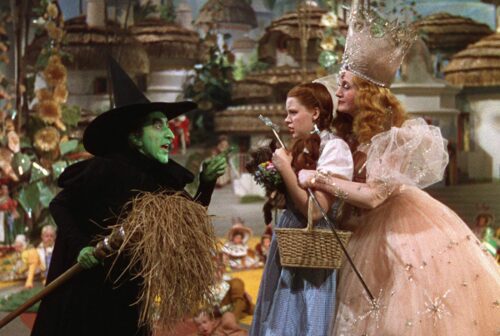
“Their magic must be very powerful, or she wouldn’t want them so badly” said Glinda the Good Witch in M-G-M’s The Wizard of Oz. Glinda was speaking about the Ruby Slippers and the Wicked Witch of the West, who pursued Dorothy throughout most of the movie to get them. But ever since the dispersal of M-G-M’s props and costumes in 1970, the chase for the actual Ruby Slippers has become an adventure drama of its own. One of its final dramatic chapters culminated in the December 7, 2024 sale at the Heritage Auction Co. in Dallas of the Michael Shaw pair of Ruby Slippers. The pair of Ruby Slippers set a record for Hollywood memorabilia, selling for $28 million ($32,500,000 with premium). There were many bidders over 14 minutes with a final battle between two phone bidders. This is the pair that had been loaned by Shaw to the Judy Garland Museum in Grand Rapids, Minnesota, Judy Garland’s birthplace. Incredibly, the Ruby Slippers had been stolen from the museum in a nighttime smash and grab on August 27, 2005 and went missing for almost fourteen years. The circumstances surrounding the robbery could make a screenplay, though it was no Ocean’s 13.
Museum employee Kathe Johnson closed up as usual on that evening of August 27, 2005, setting the building security system. The Ruby Slippers were in an unsecured, standalone, glass case. When she returned the next morning, she noticed the alarm panel only registered “auxiliary,” instead of “armed.” Employees had been having problems with the security system. Then she saw the broken glass from the back door. She immediately called museum director John Kelsch and said in a sinking voice, “they’re gone.”[1] For budgetary reasons the museum lacked a full 24-hour recording system. And although the Grand Rapids police responded to investigate, they suspected that local teenagers had stolen the Ruby Slippers as a prank. Michael Shaw had them insured for $1,000,000. He was heartbroken when he received the news, only the beginning of the tragic events – after he was suspected of insurance fraud while actually keeping the Ruby Slippers after they failed to show up. The museum was also suspected of having hosted an inside job. Shaw was finally paid $800,000 from his insurance policy in 2007.[2] Why were these Ruby Slippers so valuable and why all the suspense? In unravelling this tale about the Ruby Slippers, as Glinda stated in The Wizard of Oz, it’s always best to start at the beginning.
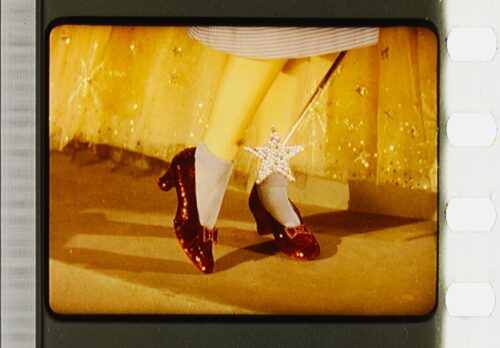
It all started with L. Frank Baum’s children’s book The Wonderful Wizard of Oz, a huge bestseller first published in 1900. The story and its characters were so popular that Baum wrote several sequels and even produced a Broadway play and some silent films. In the book, Dorothy’s slippers are described as silver, not red. The use of color changed markedly between the book production methods of 1900, where expensive color printing was used sparingly, and Technicolor film in 1939, where the land of Oz exploded in color from one black and white scene in Kansas to the next scene in Oz. Under the bright lights needed for Technicolor, silver shoes would not have made the glowing impression of the Ruby Slippers, especially against the Yellow Brick Road. It has been noted that the screenwriter Noel Langley in a revision to the script’s stage directions for The Wizard of Oz, he had substituted “the ruby shoes,” for the silver shoes.[3] While credit may point to Langley for using red in lieu of silver for the slippers in The Wizard of Oz, such an important decision would more likely have been made in M-G-M’s art department, and most probably with its costume designer, Adrian, who designed the look of virtually all the Oz characters excepting the Tin Man, the Scarecrow, and the Cowardly Lion, fairly well defined in the book. Unfortunately, only two Adrian Wizard of Oz costume sketches survived, and none for the Ruby Slippers.
The Wizard of Oz was popular on its release but not a huge hit. Since then, however, due to its regular showing for decades on television, and its continued popularity, it is considered by the Library of Congress to be the most-watched movie ever. Television viewing was a main factor in the decline of revenue that sank the movie studio system including M-G-M, when in 1970, its new owner sold the studio’s vast collection of props and costumes to auctioneers the David Weisz Co. Held over twenty days, several sound stages, and three lots, props as diverse as antique furniture, bronze sculptures, stage coaches, Roman chariots, and even the three masted ship used in Mutiny on the Bounty, were sold. Antique dealers came from New York, as did actors Rock Hudson, Shirley Jones, and Nanette Fabray. Debbie Reynolds came ready for action after borrowing money from her bank. Five auction catalogs were printed, including one for the “Star Wardrobe,” which listed many of the great costumes designed for and worn by the best-known stars of M-G-M. The most expensive item throughout the sales was a pair of Ruby Slippers, which rose in bids to $15,000 in 36 seconds (comparable to $122,00 in today’s dollars). The buyer was an anonymous “Southern California millionaire.[4] The Ruby Slippers were shown to a capacity audience by a young man, holding them on stage, cradled on a red velvet pillow. The man was Kent Warner. Kent, a studio costumer, had been hired by the auctioneer to inventory M-G-M’s vast costume collection, previously estimated at 350,000 items, to make up the more select “Star Wardrobe” catalog. In lieu of a salary, Kent had asked that he be paid by bartering his time for costumes. Kent was also a passionate collector of costumes and Hollywood memorabilia, one of the first of the “Robin Hoods,” a then small group of young men, dedicated cinephiles, and collectors of film fashion, set out to preserve costumes that they saw being neglected, discarded, or otherwise left to decay in studio warehouses. Kent had set up connections with many of these “Robin Hoods” by selling them costumes he had “rescued” from various studios. In the world of classic Hollywood costume collecting, he was considered “the first.”
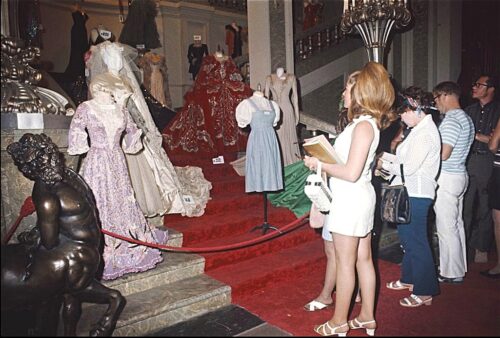
The press coverage of the auction of the Ruby Slippers went national. Roberta Jeffries Bauman of Memphis read the papers, shocked that her treasured pair of Ruby Slippers were not the only ones. She had won her pair in a 1940 M-G-M publicity event as the prize for the girl winner of a high school “10 Best Movies of 1939” essay contest (there was a boy winner for a different prize). For years she had been placing them on exhibit at various schools, and was locally famous as their owner. But now she was letting it be known that she was unhappy about the news. The purchaser of the MGM $15,000 pair was also upset when Bauman’s story made national news. He thought his was the only pair. Subsequently, in 1979 he donated his pair to the Smithsonian’s National Museum of American History. But as close friends of Kent Warner knew, he also had a pair of Ruby Slippers which he displayed proudly in his Hollywood apartment. As it turned out, he had also sold a pair to Debbie Reynolds, these were a test pair never used in the film, the so-called “Arabian test slippers,” with curled-up toes. Reynolds had been aghast at the sale of M-G-M’s movie legacy, and spent $180,000 on costumes and props in an effort to launch a future Hollywood movie museum – a project she failed to convince M-G-M to do. Kent Warner sold another pair of Ruby Slippers to Michael Shaw, the pair that was loaned and then stolen from the Judy Garland Museum. The years that the stolen Ruby Slippers were missing caused a series of events that see-sawed from comical to tragic. Reward money of $250,000 failed to flush out any local teens as suspects. A hypothesis that the shoes had been placed in a Tupperware container and sunk in a nearby lake that had once been a mine pit had divers conduct a search in 2015. Nothing was found. That effort did cause an Oz fan in Arizona to offer a $1 million reward for the recovery of the Ruby Slippers. While that flushed out dozens of tips, none led to finding them and the deadline for the reward expired. Meanwhile, private detective agencies got involved and so did the FBI. Once he was discovered, the thief was shown to be no fan of The Wizard of Oz, and had never even seen the movie. He was an aging, long-time hood named Terry Jon Martin, looking for a final caper. He had heard about the reward and the high insurance on the Ruby Slippers so he figured the shoes must have been made of real rubies. He planned to fence the rubies with an associate and ditch the shoes. He found out that the Ruby Slippers contained no real rubies, and after some time of storing them near a trailer where he lived, he turned them over to his associate who buried them in a clear plastic container in his yard for about seven years.
As often happens in capers with multiple parties, things started unraveling. An effort to return the Ruby Slippers was made, whether that was to avoid any prosecution, or to collect reward money, is unclear. From one connection to another, the thief’s long-time friend and associate had a Minnesota lawyer named Joe Friedberg that had a vacation condo in Florida. A fellow condo resident was a retired Secret Service agent named Michael Insabella.[5] In talking about the Ruby Slippers case poolside, Friedberg asked Insabella to join him as a go-between with the Merkel Insurance Company in returning the Ruby Slippers on behalf of Friedberg’s client, with the lure of reward money. To their surprise, the meeting was set up at a false coffee shop sting operation conducted by the FBI on July 5, 2018. The Ruby Slippers were seized and the two men detained and then released, with their residences searched.
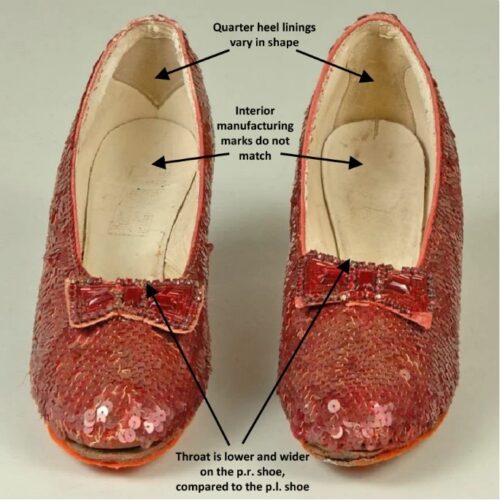
The Ruby Slippers were now In FBI custody. In order to verify that they were genuine, the FBI placed the Ruby Slippers in the custody of the Smithsonian Museum, which at that time was in the process of restoring their pair of Ruby Slippers and so could make a very precise comparison of the two sets – which revealed some remarkable features. The stolen pair were indeed genuine, but according to Dawn Wallace, objects conservator at the National Museum of American History, she concluded the following:
- The Smithsonian’s pair of Ruby Slippers are not identical shoes. Their sizes differ — 5C and 5BC, and the shoes come from two separate sets of high heels. The bows carry slightly different shapes, the heel grips are distinct shapes and the insoles are made from different types of leather.
- The two sets of Ruby Slippers were mis-matched/sister shoes
- The even hexagonal, faceted beads of the bow, only seen on the Smithsonian’s left shoe, matched beads on the FBI’s right shoe.
- The right shoe is inscribed with “#1 Judy Garland”, while “#6 Judy Garland” is marked on the left shoe. Those labels were used to track the individual pairs on set. The Ruby Slippers now at the Museum of the Academy of Motion Pictures, are both labeled #7 Judy Garland.
Additionally:
- The bows were handcrafted out of a stiff, loose weave red fabric support covered in the same red mesh, to which red beads and rhinestones (referred to here as “stones”) were attached. The beads (three large rectangular and many bugle) were sewn directly to the bow, while the stones were held by prong settings which are sewn to the bow. The finished bow is sewn at the top center of the vamp.
- The sole was painted red, presumably to complete the red appearance over the entire shoe.
- A layer of orange felt was glued to the shoe’s sole to dampen the sound[6]
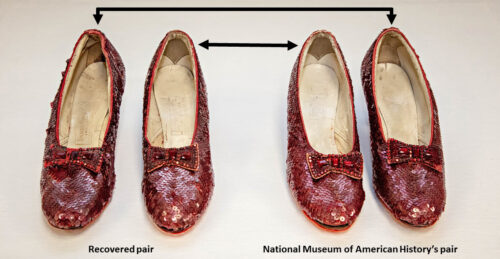
The numbering of the different pairs of Ruby Slippers described above, from Dorothy #1, #6, and #7 begs the question, were there Dorothy slippers 2,3,4 and 5? If we account for the known Ruby Slippers, there are the #1 and #6 the mismatched pairs belonging to the Smithsonian/National Museum of American History and the Michael Shaw/stolen pair. The #7 pair, which had been owned and displayed in Kent Warner’s home, is now at the Academy of Motion Pictures Arts and Sciences Museum. One pair, number unknown, was known to have been chewed up by Toto during the film’s production. Roberta Bauman’s pair won from M-G-M, does not appear to have a Dorothy #, but “Double” which may indicate they were worn by Judy’s double. Bauman later put them up for auction in 1988 – they sold for $165,00 to Anthony Landini, who displayed them at Disneyworld. Landini was also a passionate fan of Judy Garland and Oz. He attended Garland’s concerts 35 times and then attended her funeral in New York City. Finally owning the Ruby Slippers was the culmination of his dreams. “They just represented the beauty of the film and the innocence of Dorothy,” he told journalist Tim Gihring.[7] In 2000 he sold them at auction for $666,000 to David Elkouby, owner of Starworld, who put them in a vault. So that still leaves a potential three pairs of Rubby Slippers unaccounted for. The Arabian test pair with curled up toes and arabesque crystal patterns, which was sold at the Debbie Reynolds auction to a gentleman from the Middle-East. There was another test Ruby Slipper pair that was covered in red bugle beads but without a bow. Adrian did not think this reflected light as well as the sequins, plus it was a heavier shoe for Judy, so it was never used and likely never had a number. Was it discarded? Even a test pair would be valuable. There was also the possibility that some pairs were purposely destroyed after Kent Warner discovered them in order to keep the value high for the auctioned pair. What likely happened is that an older costumer that had suggested Kent for the job, and the former head of women’s wardrobe each received a pair.[8] And another pair may still be in private hands. There are also questions about whether all the Ruby Slippers were made at M-G-M from the basic Innes pumps or whether some were also made at Western Costume Co., as eyewitness reports indicate.[9]
This brings us back to Kent Warner. The pair he had kept for himself and had on display at his apartment, these were the ones in the best condition. When he became ill from Aids, he needed to put them up for auction in order to pay his medical bills. He tried to sell them in 1977 at a memorabilia auction in Los Angeles, but they did not meet his reserve price of $20,000. He tried again, more desperate for money, at Christie’s East in 1981, where they only fetched $12,000. Kent thought they were worth $75,000. In 1988, two weeks after the sale of the Bauman pair, the anonymous buyer of Kent’s Ruby Slippers offered his pair to Philip Samuels, the underbidder of the Bauman pair, for $165,000. In 2011, the Profiles in History auction house placed the Kent Warner/Samuels’ Ruby Slippers, as the highlight of its “Icons of Hollywood” auction. The shoes were estimated at 2-3 million dollars. They failed to sell, but a group consisting of Leonardo DiCaprio, Steven Spielberg and Terry Semel bought them from the auction house for the Academy Museum. Kent Warner had been mostly raised by his grandmother, who would often take him out to the movies or to plays. He never lived to see such auction prices, which he would likely have been surprised to see. The money would have been a valuation of his judgment and taste. What the Ruby Slippers meant to him was best expressed in an interview with Los Angeles Times journalist Kathleen Hendrix in 1977, “I think the film The Wizard of Oz released in 1939 was the ultimate representation of home, family, solidarity, well-being, security – at the same time there was the madness and the fantasy of Oz. All I can think of is the heels clicking and Judy saying, ‘There’s no place like home.”
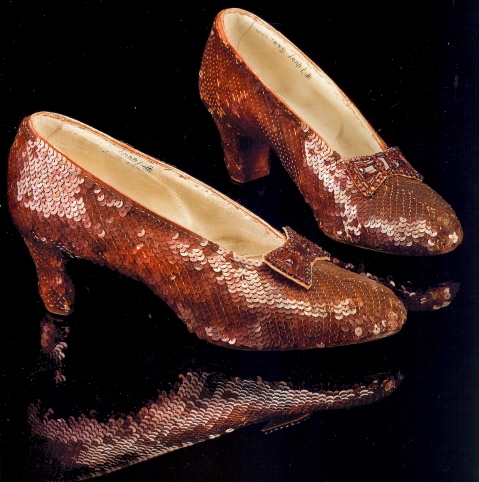
Kent Warner’s original pair of Ruby Slippers are pictured above.
[1] GUILTY, The Road to Dorothy’s Stolen Ruby Slippers – United States vs Terry Jon Martin. https://insurancenewsnet.com/oarticle/guilty-the-road-to-dorothys-stolen-ruby-slippers-united-states-vs-terry-jon-martin-part-4
[2] Sam Wolfson, “FBI finds stolen ruby slippers from Wizard of Oz after 13 years.” https://www.theguardian.com/film/2018/sep/04/judy-garland-stolen-ruby-red-slippers-recovered-fbi
[3] Dwight Blocker Bowers, The Ruby Slippers: Inventing an American Icon. http://www.smithsonianmag.com/arts-culture/smithsonian-institution/What-Happened-to-the-Wizard-of-Oz-Costumes-and-More-Great-Questions-From-our-Readers-204140921.html#ixzz2aSi8FBkV
[4] Rhys Thomas, “The Ruby Slippers: A Journey to the Land of Oz,” The Los Angeles Times, March 13, 1988.
[5]Pam Dowell, “Dorothy’s stolen ruby slippers on tour with more questions than answers.” https://duluthreader.com/articles/2024/11/07/129791-dorothys-stolen-ruby-slippers-on-tour-with
[6] Douglas, J.G., Kavich, G., Mori, C. et al. Materials characterization of the Ruby Slippers from the 1939 classic film, The Wizard of Oz. Herit Sci 6, 49 (2018). https://doi.org/10.1186/s40494-018-0214-1
[7] Tim Gihring, Who Stole the Ruby Slippers: Suspicious Munchkins, Hollywood hucksters, and lunatic fans (oh, my): Inside the very weird and not so wonderful search for an American icon, February 19, 2009. https://www.minnesotamonthly.com/archive/who-stole-the-ruby-slippers/
[8] Rhys Thomas. The Ruby Slippers of Oz: Thirty Years Later. RCT Publications, 2018. 244-246.
[9] https://silverscreenmodes.com/western-costume-companys-golden-age/
Views: 1367

Great sleuthing & thanks for drawing all the threads together for this ongoing saga! Jaci
Thanks Jaci. I’m glad you enjoyed this post. There were many facets to these rubies.